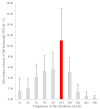Fifty Years of Development of the Skull Vibration-Induced Nystagmus Test
- PMID: 35076447
- PMCID: PMC8788279
- DOI: 10.3390/audiolres12010002
Fifty Years of Development of the Skull Vibration-Induced Nystagmus Test
Abstract
This review enumerates most of the studies on the Skull Vibration-Induced Nystagmus Test (SVINT) in the past 50 years from different research groups around the world. It is an attempt to demonstrate the evolution of this test and its increased interest around the globe. It explores clinical studies and animal studies, both permitting a better understanding of the importance of SVINT and its pathophysiology.
Keywords: Skull Vibration Induced Nystagmus Test (SVINT).
Conflict of interest statement
The authors declare no conflict of interest.
Figures


Similar articles
-
[Skull vibration induced nystagmus test].Ann Otolaryngol Chir Cervicofac. 2007 Sep;124(4):173-83. doi: 10.1016/j.aorl.2007.05.001. Epub 2007 Sep 29. Ann Otolaryngol Chir Cervicofac. 2007. PMID: 17678612 French.
-
The Skull Vibration-induced Nystagmus Test (SVINT) for Vestibular Disorders: A Systematic Review.Otol Neurotol. 2021 Jun 1;42(5):646-658. doi: 10.1097/MAO.0000000000003022. Otol Neurotol. 2021. PMID: 33492062
-
The skull vibration-induced nystagmus test: A useful vestibular screening test in children with hearing loss.Eur Ann Otorhinolaryngol Head Neck Dis. 2020 Dec;137(6):451-457. doi: 10.1016/j.anorl.2020.03.013. Epub 2020 Apr 17. Eur Ann Otorhinolaryngol Head Neck Dis. 2020. PMID: 32312623
-
Nystagmus induced by high frequency vibrations of the skull in total unilateral peripheral vestibular lesions.Acta Otolaryngol. 2008 Mar;128(3):255-62. doi: 10.1080/00016480701477677. Acta Otolaryngol. 2008. PMID: 17851918
-
The Neural Basis of Skull Vibration Induced Nystagmus (SVIN).Audiol Res. 2021 Oct 14;11(4):557-566. doi: 10.3390/audiolres11040050. Audiol Res. 2021. PMID: 34698054 Free PMC article. Review.
Cited by
-
Is Skull-Vibration-Induced Nystagmus Modified with Aging?Audiol Res. 2022 Mar 4;12(2):132-142. doi: 10.3390/audiolres12020016. Audiol Res. 2022. PMID: 35314611 Free PMC article.
-
Visual Fixation of Skull-Vibration-Induced Nystagmus in Patients with Peripheral Vestibulopathy.Audiol Res. 2024 Jun 24;14(4):562-571. doi: 10.3390/audiolres14040047. Audiol Res. 2024. PMID: 39051191 Free PMC article.
References
-
- Dumas G., Michel J., Lavieille J.P., Ouedraogo E. [Semiologic value and optimum stimuli trial during the vibratory test: Results of a 3D analysis of nystagmus] Ann. d’Otolaryngol. Chir. Cervico. 2000;117:299–312. - PubMed
Publication types
LinkOut - more resources
Full Text Sources
Miscellaneous

